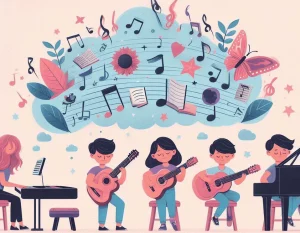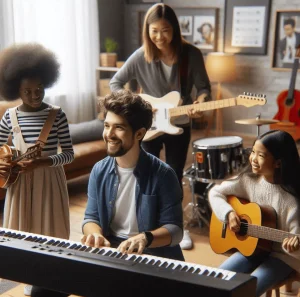‘Music creation has changed, fan behavior has changed, and therefore, artists’ needs for digital music distribution have changed too.’

Table of Contents
The following MBW op/ed comes from Andreea Gleeson, Chief Executive Officer of Believe-owned DIY distribution company TuneCore. Gleeson’s op/ed follows the platform’s announcement this week that it is introducing new ‘Unlimited Release Pricing Plans’.
I may be a lifelong fan and lover of music, but I’m not from the music industry. My background is in retail. I was employee #3 in the e-commerce department of a major department store where we took shopping online and grew it from the ground up to over a $300 million dollar business.
We did this by understanding customer needs and adapting our services to meet them. Since becoming CEO of TuneCore last year, I have taken a similar approach to driving impact in the DIY music sector for self-releasing artists.
We took a close look at our independent artists and labels and embarked on a deep dive into what they need to be successful. Over the course of the last year, I’ve spoken personally to dozens—no, hundreds—of artists, asking them how TuneCore can better serve them.
The company conducted extensive research through focus groups and surveys with music creators at all stages of their careers. From these studies, a common thread that emerged is “change.”
Music creation has changed, fan behavior has changed, and therefore, artists’ needs for digital music distribution have changed too. Today’s artists are focused on constant creation and keeping fans engaged.
Another thread that materialized during our research is “control.” Indie artists continue to want control over their own artistic fate and to manage the way their careers progress. These closely related desires have impacted the way fans interact with their favorite artists and how these creators release their music. Artists want the freedom to create music at their own pace and release music at their choosing.
Two common threads “Change” and “Control”
We learned that self-releasing artists are creating music way more frequently than ever before and they should. Gone are the days where release strategies are directly tied to shelf space and physical manufacturing constraints. Today music is consumed digitally from an endless virtual aisle and as such, successful release strategies have shifted from doing an EP or album per year to releasing singles more often and more regularly.
This allows indie artists to take full advantage of all the channels at their disposal to animate their releases and engage with potential fans. From teasing a release to encouraging presaves and celebrating streaming milestones on Instagram and TikTok, to sharing the story behind a song or posting a lyric video on YouTube, all the digital platforms have one thing in common, the algorithms reward constant music creation.
With each release, an artist creates a new opportunity for fans to engage with their music and today, the cross pollination between social media and streaming platforms is directly fueling music discovery and fandom.
Case Study: Alexandra Kay fusing together social media with download and streaming platforms to fuel discovery and continually engage fervent fans
Nashville-based Alexandra Kay has been self-releasing music through TuneCore since 2015. Kay had previously been signed with a major label who dropped her due to creative differences, Kay stuck to her roots and continued to release music independently. Over the pandemic, she shared her story on TikTok and encouraged potential fans to pre-save her upcoming release “I Kind of Don’t.” The post went viral, amassing millions of views and propelled her to #1 on the iTunes Country chart just hours after the song was released.
A few months later, she launched a “Coffee Covers” series on TikTok, which quickly became viral, growing her followers to 3.1 million on the platform. Many of her covers garnered millions of views on TikTok and even got the attention of big country stars like Randy Travis (cover, duet & in-person meet), Sara Evans (cover & duet) and Tim McGraw (cover & duet). After seeing her cover his song on TikTok, McGraw contacted Kay personally to invite her to tour with him this summer and she’s been opening for him on his 17 shows.
Kay has gained 700,000 monthly listeners on Spotify, 1.3 million followers on Facebook, and 244,000 on Instagram. Her singles “How Do We Go” has over 5M streams on Spotify and “I Kind of Don’t” has 4 million, organically without playlisting. She recently graced the cover of Pollstar magazine, after garnering her third No.1 song on the iTunes Country chart and reaching No.3 on the Billboard Digital Country chart with “That’s What Love Is.” Kay’s success is directly driven by her experimentation and iteration on what is working for her and fusing together her social media and releases into a holistic experience for fans. As an example, lets take a look at Kay’s timeline for the release of her hit single, “How Do We Go.”
Ahead of the song’s release she teased out the song with multiple posts on TikTok:
After the song released on June 30th, she encouraged its continued discovery with a series of posts:
She also posted celebratory videos for her streaming milestones, making her fans feel part of the success:
- August 8, 2021 1M streams milestone (566,000 views)
- February 6, 2022 6M streams milestone (2.1m views)
- March 27, 2022 7M streams milestone (457,000 views)
We can see that utilizing social media helped propel Kay’s single into millions of views and streams. It also laid the foundation for her to continue delivering viral videos in her “Coffee Covers” series, embark on two tours, and release three more songs – Tall Boys (1.2 million Spotify streams), “Best Worst Ex” with Julia Cole (2.4 million Spotify streams), and her most recent release, “That’s What Love Is,” (500,000 Spotify streams).
With a voice reminiscent of Dolly Parton, Alison Kraus and Leanne Womack, Kay is defying the original creative direction of the major label she was previously signed to and is showing that she can be successful by staying independent and true to herself. Her undeniable voice and songwriter skills coupled with her analytical yet creative approach to release planning, makes me so excited to see where she goes to next.
TuneCore is focused on two key priorities – to help artists “make their music better” and “become better known.”
I often tell my team that “if our artists are successful, then we’re successful” and for this reason, we have evolved TuneCore’s focus around two key priorities – to help our artists “make their music better” and to help them ”become better known.” By making this our goal, it not only builds a greater relationship between our company and our artists and labels, but it also strengthens the music market as a whole. According to MIDiA Research, independent labels, and artists direct (self-releasing artists) generated $10 billion and represented 34.7% of the market in 2021. Alone, artists direct represent 5.3% of the market, about $1.5 billion out of the total $10 billion. These are artists and labels that TuneCore was created to represent. And they are the fastest growing segment of the creator community.
Since TuneCore’s inception, when it disrupted the music industry by introducing the first flat fee pay-per-release distribution model on the market, it has been in our DNA to understand unmet artist needs and bridge them. In November of last year, we identified a gap in the industry that led us to launch “Social Platforms,” a feature that allows TuneCore artists to upload their music directly into the music libraries of social media services like TikTok, Facebook, Instagram, Reels and YouTube Shorts as a pre-step to distribution for no upfront fee.
We are proud to have launched a first-of-its-kind service that productizes the usage of social media platforms – so indie artists can make money, while experimenting and testing their music. The fans will ultimately make or break an artist’s career so: why not let them decide what they want to hear from the outset? It’s crowdsourcing at its best and it delivers on our key mission to help our artists get the direct feedback they need to “make their music better” while also helping them “become better known.”
Constant music creation needs to be more accessible for artists, so TuneCore changed its pricing and is introducing Unlimited Plans.
As we focused on further evolving TuneCore to help our artists grow, it became evident that our pay-per-release flat fee distribution model was no longer meeting the needs of our artists. In 16 years, TuneCore never changed its pricing . This is why I am excited to announce that we are introducing new, innovative Unlimited plans that make constant creation more accessible for every artist.

We’ve structured our new model featuring curated pricing plans to give artists the control they crave and deserve. We understand that not every artist has the same needs. We also know that in the past, our services have been unattainable for some artists, due to our high prices. Today, we are throwing open our doors to everyone—no matter what’s in their wallet.
Starting at just $14.99 per year, with the “Rising Artist” plan, creators can distribute unlimited releases to over 150 streaming and download platforms while retaining 100% of their revenue. This plan also includes access to pre-schedule all release date, something our research revealed was highly valued no matter what phase of their career an artist was at. Additionally, TuneCore will continue to offer our free “New Artist/ Social Platforms” service, a “Breakout Artist” plan which offers a slew of additional features including Store Automator for $29.99 and a premium “Professional Plan,” great for labels or artists further along in their careers for $49.99, where more sophisticated distribution features and faster artist support is available.
Each of these plans was thoughtfully curated to meet the unique needs of artists and labels at different stages of development. An artist who has 100 followers on Instagram with 5 monthly Spotify listeners is at a very different stage of their career and has different needs than Alexandra Kay for example. As such we created affordable plans for artists at the start of their careers, while on the other end of the spectrum, providing more sophisticated release features for more advanced artists and labels and everything in between. While each of the plans is unique, one thing we made sure of is that all plans encouraged and reduced the barriers to constantly release music which we see as essential to enabling artists to build their audiences and artistry today.
I’m not the only one that believes that consistent creation will be the norm in the future. Spotify co-founder, Daniel Ek has said, “The artists today that are making it, realize that it’s about creating a continuous engagement with their fans. It is about putting the work in, about the storytelling around the album, and about keeping a continuous dialogue with your fans.”
The rise of this constant creation along with the growth of indie artists in control of their careers shows no sign of slowing and the companies in this space that embrace how music creation, promotion and consumption has changed will rise too.Music Business Worldwide







